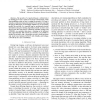12 search results - page 1 / 3 » Residual investigation: predictive and precise bug detection |
ISSTA
2012
ACM
11 years 11 months ago
2012
ACM
We introduce the concept of “residual investigation” for program analysis. A residual investigation is a dynamic check installed as a result of running a static analysis that ...
CAV
2010
Springer
2010
Springer
Universal Causality Graphs: A Precise Happens-Before Model for Detecting Bugs in Concurrent Programs
13 years 11 months ago
Triggering errors in concurrent programs is a notoriously difficult task. A key reason for this is the behavioral complexity resulting from the large number of interleavings of op...
MSR
2010
ACM
14 years 2 months ago
2010
ACM
—The severity of a reported bug is a critical factor in deciding how soon it needs to be fixed. Unfortunately, while clear guidelines exist on how to assign the severity of a bu...
BMCBI
2007
13 years 9 months ago
2007
Background: Recognition of binding sites in proteins is a direct computational approach to the characterization of proteins in terms of biological and biochemical function. Residu...
BMCBI
2010
13 years 9 months ago
2010
Background: Non-coding RNAs gain more attention as their diverse roles in many cellular processes are discovered. At the same time, the need for efficient computational prediction...

